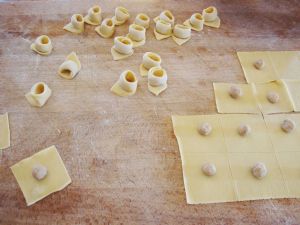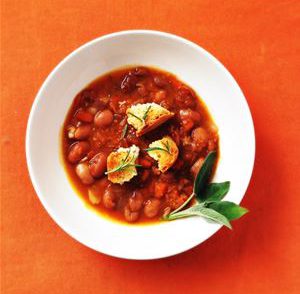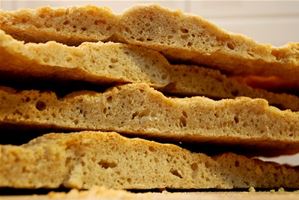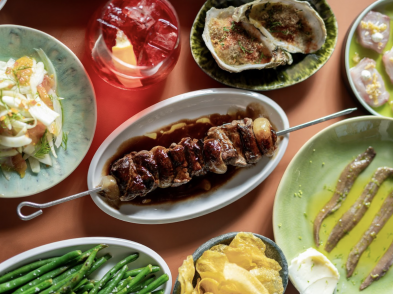La gallina vecchia fa un buon brodo: ‘An old chicken makes a good broth’ is one of Italy’s time-tested aphorisms. And whether you believe that tortellini-filled-pasta parcels, usually served in broth or with butter and cheese-is Tuscany or Emilia Romagna’s contribution to Italian cuisine, tortellini al brodo di pollo is one of winter’s most satisfying food pleasures.
At this time of the year, after the Christmas feasts, I find myself longing for the flavours of tortellini al brodo di pollo, which many of my Italian friends include on their tables for the long night of Christmas Eve.
This comfort food of rich, fragrant winter chicken broth reminds me of my mother’s soul food, but with the Italian addition of homemade pasta tortellini with a ripieno (‘stuffing’) of pork loin, prosciutto crudo, mortadella and parmigiano reggiano. Winter vegetables are, for the most part, root vegetables, and these add to the fragrance of the broth. Indeed, the special ingredients of the tortellini filling combine magically to keep body and soul satisfied while waiting for spring.
Not surprisingly, there is some rivalry regarding the origins of tortellini. While some claim that northern neighbour Bologna, in Emilia Romagna, is the source of the first or best tortellini, Tuscans also claim tortellini, which they eat during the festive season and the cold months that follow, as their regional pasta.
Native to central Italy, tortellini has legends and even poetry dedicated to its origins. Perhaps it really did come from the gods, as native Florentine (yet Bolognese by adoption) Giuseppe Ceri professed in his nineteenth-century poem Venus’ Navel. According to Ceri, the pasta evokes a glimpse of Venus’ navel following an amorous night she spent in an inn in Emilia with the gods Bacchus and Mars.
Or perhaps tortellini were invented by an innkeeper near Modena who went into raptures upon seeing the navel of his guest Lucrezia Borgia, the famously bewitching illegitimate daughter of Pope Alexander VI, and wanted to imitate it in the kitchen?
One thing is certain: when made at home, tortellini are usually divine, and the traditional filling is a mix of top-quality ingredients: mortadella, prosciutto crudo, and parmigiano, some of Italy’s top foods, all produced near the border of Tuscany and Emilia Romagna. Regional rivalry, however, pales in the face of intense discussions about whose nonna makes the best stuffed tortellini and with which ingredients, since every family follows its own tradition with its own special ingredients and methods.
Here is a recipe for making a delicious part of Tuscan culinary fare at this time of year. Buon appetito!
RECIPE
BRODO DI GALLINA
The goal is a broth that is clear yet rich and fragrant. Following the Italian maxim, choose an old hen that’s too lean and tough to roast. You’ll also need a small carrot, a yellow-skinned onion, two stalks of celery (without leaves, for these will cloud your stock), six peppercorns and a bay leaf. From the chicken, cut off the head and any visible fat and loose skin. Wash and peel the carrot, clean the celery stalks and cut the onion in half without skinning (the yellow of the skin colours the stock and intensifies flavour). Place all ingredients in a stockpot, cover with cold water and bring to boil. To produce a clear broth, which is the goal here, once boiling point is reached, reduce the heat to a low simmer and skim constantly to remove the impurities and fat that will rise to the surface.
Continue cooking at a gentle simmer for three hours. Remove the pot from the heat and let it sit for 10 minutes. Then gently ladle off the liquid through a fine strainer into a clean cooking pot. Season to taste with sea salt and set aside while you make the tortellini.
Pasta dough Use 10 yolks to 250g of durum wheat flour, a sprinkle of water and a drizzle of extra virgin olive oil. Sieve the flour straight onto the work surface and make a deep well in the centre. Place the egg yolks with the water and extra virgin olive oil in the well, mix in with your fingertips and knead by hand until soft, shiny and elastic. If it’s too tough, add a sprinkling of water until it is soft to the touch, easy to knead but not sticky. Leave the dough to rest at least 10 minutes while you make the filling.
Tortellini filling To make the ripieno, take 120g mortadella, 120g pork loin, 120g prosciutto crudo, one egg and 100g parmigiano reggiano. Dice up the first three ingredients (leaving the fat on the crudo) and throw them together in a food processor, mixing in the whole egg, the grated parmigiano and salt and pepper to taste.
To make the tortellini Roll the dough as thin as possible with a small amount of flour and cut into 5cm squares. Take a very small quantity of ripieno, about what you think equates to the filling of one tortellino, then halve it; it should truly be only about half a coffee spoon in size. Place in the middle of each 5cm pasta square and fold diagonally, covering the filling and making sure all air is removed and the edges are sealed. The little square, now a triangle, should not be too plump with stuffing. With the longer folded edge nearest to you, lift and pinch the two side corners, and fold round towards yourself, pressing the two slightly stretched overlapping points together. You will have created something resembling a cross between the little ombelico di Venere and a pope’s mitre. This recipe makes about 200 tortellini.
The composition Heat the seasoned brodo to a simmer, drop in the tortellini and cook until they float to the surface of the broth, after about two to three minutes; ladle the brodo with the tortellini into soup bowls, sprinkle with some grated parmigiano reggiano and serve with a spoon.
WINE MATCH
This dish is a good match for the Gaiole IGT 2006, Casa al Vento in the Gaiole area of Chianti Classico. A mix of 60 percent sangiovese grapes and 40 percent merlot, it is Tuscan enough to be delicious, yet the high percentage of merlot adds a distinct softness and smoothness to the fruity finish.








